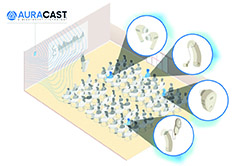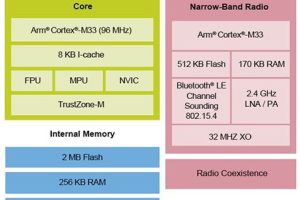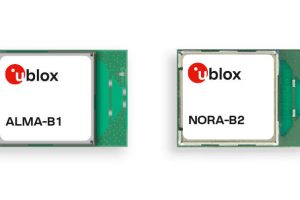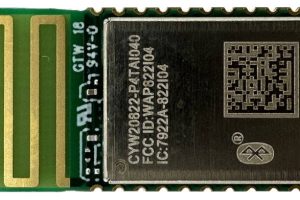
In early December 2020 the Bluetooth SIG (Special Interest Group) released revision 5.2 of Bluetooth. One of the key upgrades was the addition of BLE Audio (Bluetooth Low Energy Audio). Releasing a spec is just the start of a process and it is only today that real IoT devices are finally available with BLE Audio capability.
What is BLE Audio and what specification enhancements were required? In many ways it isn’t complicated.
Up to version BLE 5.1, the focus for Bluetooth was data transmission for IoT wireless data exchanges. Under this type of use case the focus was reliable data transmission. This means that if a data packet is lost (which is normal for wireless), the system retries the transmission so all the data arrives, albeit with some delay. This is what IoT users want. The low energy aspect of BLE is ideal for IoT devices, which require occasional data transmission and spend the rest of their time in sleep mode. The initial generation of BLE devices, however, lacked the processing power and memory for sophisticated applications.
Could BLE Audio have been implemented earlier? Technically, yes – but with great effort. However, it simply wasn’t a priority because the original Bluetooth Classic did the job. BLE specs focused on applications that BT Classic could not support.
Classic and BLE
Bluetooth, now referred to as Bluetooth Classic, was launched in 1999. The idea was a cable replacement technology that could link diverse devices. It was for local connections, that is around 10m-20m and for simple low data rate applications, initially at rates of 1Mbit/s base rate, with real throughput at best half that, less if over longer distance or with obstacles.
Some technical issues limited take-up. These were:
* It required constant wireless data connection, meaning devices quickly drained power. Users found in many cases the problems outweighed the benefits
* Although Bluetooth is open and interoperable, in practice, interoperability was poor
* Connecting two devices with any kind of security was hard
* Recovery from connection loss often failed.
Initially Bluetooth Classic had little traction and was misunderstood. Users found the technology more troublesome than helpful, especially the aspect of keeping devices powered; cables seemed easier.
Evolution of Bluetooth
As is often the way with technology, the early adopters persisted. Technology gradually progressed, and silicon chips and modules used for Bluetooth improved significantly.
There were some specific use cases that started to become popular, for example, the wireless computer mouse and keyboard. There was also streaming audio, for which users seemed willing to keep charging devices.

Figure 1: Auracast for multi-cast BLE Audio allows a single source to transmit to several devices
Initial audio streaming devices were a simple single earbud connected to a phone. The quality was poor, but over time (more than a decade) the quality improved and hi-fi quality devices are extremely popular. These solutions will persist for many years due to the sheer quantity of legacy devices that will remain in use by consumers. The popularity of Bluetooth is guaranteed, due to its native presence on computers, tablets and smartphones.
Bluetooth Low Energy, launched in 2009, was aimed at a different kind of use case. It sought to fulfil the original vision of cable replacement.
Bluetooth and BLE merge
Why BLE Audio today? There are a few reasons. The main ones are that it makes no sense to maintain two parallel Bluetooth standards and that the Bluetooth chips and modules have improved so much that they can cover both protocols.
Put simply, Bluetooth Low Energy Audio is better than Bluetooth Classic. Specifically, it consumes less power, has longer range and offers a higher quality audio quality. Note that both Bluetooth Low Energy and Bluetooth Classic use the same 2Mbit/s raw data rate and identical over-the-air encoding schemes.
For an audio solution, unreliable data transmission is not wanted because this would give you a ‘gappy’ sound. If packets need to be held for a retry for audio, a streaming approach is preferable. A packet can be sent and if it does not arrive, it is noted and the system moves to the next packet, regardless. This feature is called isochronous channels. Listeners hardly notice. Only in the event of a major packet loss will a noticeable drop in sound quality be detected. Even so, streaming is still the best approach.
Strictly speaking, LC3 codec is not part of BLE 5.2, in the sense that the codec could be used for any compression/decompression task. It is interesting because it gives good perceived audio quality at a lower data rate than the current codecs. It should be noted that BLE 5.2 did not provide any data increase. It remains at a (nominal) 2Mbits/s with a max theoretical ‘ideal’ real throughput at around 1Mbit/s. In the real world, at a realistic distance and use case, it will drop off further with range.
BLE advantages
The benefits of Bluetooth Low Energy compared to Bluetooth Classic are:
* Lower power consumption
* Better audio quality
* In certain use cases, simpler technical implementation
* Better latency.
Lower power consumption is achieved by allowing the radio to fall asleep if there is no data to transmit. One could expect that for an audio stream, the radio might be on a large fraction of the time, nevertheless, there will times when this is not the case, for example, quiet passages, gaps between tracks, simple passages of music, voice calls. One could imagine the power savings to be down to 50% or less, depending on exact circumstances. The data intensity of an audio stream is quite variable, depending on its nature.
Better audio quality is achieved via the LC3 codec.
Earbuds use case
Bluetooth Classic has a single over-the-air wireless data stream. For a connection to over-ear headphones this is fine as a wire can be run inside the headband. For wireless earbuds, however, this is an issue.
It is necessary for the source, typically a smartphone, to stream to one earbud in stereo. Then this earbud must stream the other channel to the second earbud. This means the mid-earbud requires more complicated hardware and software. It can also lead to poor audio quality, as the wireless signal must traverse the head, which leads to possible loss in audio quality.
New BLE Audio features
Bluetooth Low Energy offers some new features. These are:
* Multi-cast, known by the brand Auracast. This allows one source (smartphone) to transmit to several ‘sinks’ (speakers, headphones)
* Multi-channel. A single source can transmit a different stream to many sinks.
The maximum number of sinks supported is 31, although it is doubtful that any hardware exists to support this number, but an advanced audio standard such as Dolby 7.1 could be supported.

Possible new use cases for BLE Audio are:
* Public space receipt of audio stream on personal headphones. One could imagine in a public space, say an airport or train station, where there is a screen showing content, or just noise making it hard to hear announcements. An Auracast stream can allow the user to enjoy the content or hear the announcement above the noise
* Surround sound. A multi-channel solution can allow a surround sound experience via BLE Audio
* Live performance. A multi-channel solution can allow a wireless solution of multiple instruments playing together
* Multi-language. In an international conference a multi-channel wireless solution could enable participants to select their language of choice, as provided by interpreting services.
This kind of service of course already exists, but typically via wired and switched headsets, often requiring a seated environment. A wireless solution, by contrast, would for example allow a speech at a reception, say, to be translated, while delegates circulate.
Today the first generation of audio products supporting Bluetooth Low Energy Audio including headphones are now on the market. ABI Research estimates that three billion BLE Audio enabled devices will ship annually by 2027. The analyst also expects 2.5 million Auracast broadcast audio locations will be deployed globally by 2030.
Phones, tablets and computers are progressively being equipped and upgraded with the supported hardware and software, often only a software upgrade is required.
As with any new technology, full rollout and adoption take time, but a higher quality, lower power Bluetooth Low Energy is coming.
 Electronics Weekly Electronics Design & Components Tech News
Electronics Weekly Electronics Design & Components Tech News



